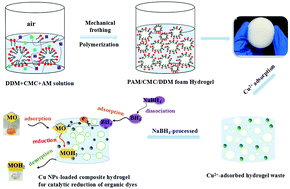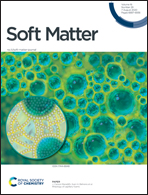Eco-friendly floatable foam hydrogel for the adsorption of heavy metal ions and use of the generated waste for the catalytic reduction of organic dyes†
Abstract
Benefiting from their three-dimensional network structure and various functional groups, hydrogels have emerged as efficient adsorbents for the removal of heavy metal ions from wastewater. However, the obvious drawbacks of hydrogels such as generation of toxic secondary waste after adsorption and difficulty in their separation and collection limit their practical application in wastewater treatment. Herein, we introduced a facile strategy of combining mechanical frothing and in situ radical polymerization to prepare a floatable porous foam hydrogel, which not only efficiently removed Cu2+ from water, but also could be easily collected. After adsorption, to avoid the generation of secondary toxic waste, a sustainable strategy of turning the waste into useful materials was introduced. The waste of the Cu2+_ adsorbed hydrogel was processed using NaBH4 solution to obtain a Cu nanoparticle (Cu NP)-loaded composite hydrogel, which was further employed as a catalyst for the catalytic reduction of organic dyes. Thus, this work established a convenient and sustainable strategy for the preparation of an eco-friendly floatable foam hydrogel for the efficient removal of heavy metal ions such as Cu2+ from water and turning the generated waste into useful materials, which is a concept envisaged to be applicable to other heavy metal ion-adsorbed hydrogel systems and will efficiently avoid unwanted secondary pollution.



 Please wait while we load your content...
Please wait while we load your content...